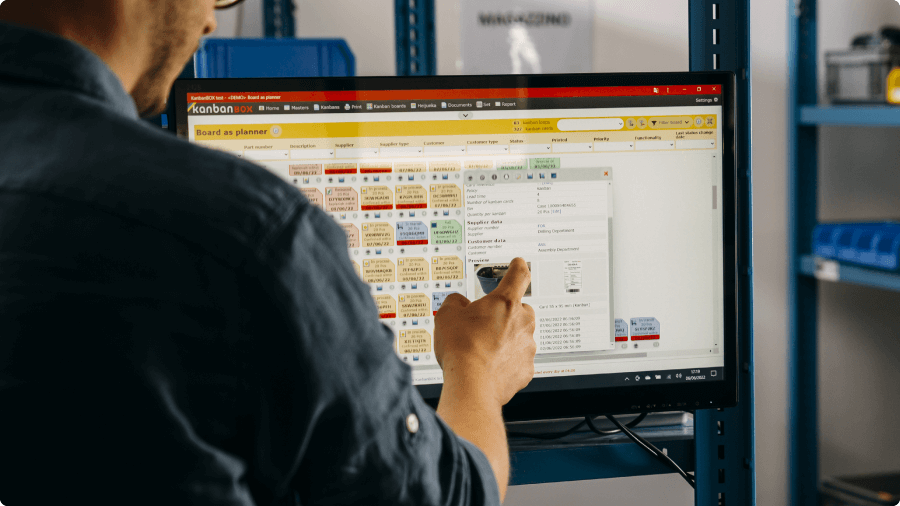Manual Kanban: 10 Limitations that hinder your Productivity
Kanban system is an excellent solution for efficient materials management in manufacturing companies. However, as the number of components and suppliers managed increases, it’s impossible to ignore the problems resulting from their physical-only management. These issues significantly impact the operational efficiency of the organization, generating delays in the production and supply phases, affecting customer satisfaction and the company’s reliability. What are the limitations of manual kanban which hinder your productivity? We found 10 main limits we are going to share with you.
|
|
Manual kanban: what are the limitations?
Managing materials with manual kanban system presents numerous challenges, which can be grouped into three macro categories: communication problems, maintenance problems and data management problems.

Communication problems of manual kanban
In traditional kanban system, physically transporting kanban cards leads to various communication issues, both internally and externally.
|
|
Internal communication problems
- Resource allocation: the company is forced to dedicate employees, tools and time to collect and deliver kanban cards, diverting these resources from higher value-added activities.
- Kanban card damage or loss resulting in partial or failed information transmission. This causes production errors and delays.
- Lack of tracking: without tracking, the operator cannot detect errors in order transmission (e.g. duplicates, missing items, oversights), negatively impacting productivity.
External communication with suppliers
- Delayed communication: time passes between the moment a kanban card is collected and when the supplier receives the information about the new order, potentially leading to stockouts.
- Lack of immediate feedback: inability to obtain immediate feedback from suppliers about requests or material conditions. This creates a disconnection between the company’s needs and suppliers’ capabilities.
|
|
Maintenance problems of manual kanban
Maintenance refers to operations necessary to maintain system functionality and efficiency. Traditional kanban presents limitations in this area because of:
- High cost of kanban maintenance: updating sizing of kanban loops and monitoring parameters used to calculate them require significant time and trained personnel
- Lack of/rare sizing maintenance activity: since it’s expensive, kanban sizing are rarely updated, compromising responsiveness to demand changes.
- No performance indicators: without performance control indicators, the company cannot effectively optimize its processes.
|
|
Data management problems of manual kanban
Traditional kanban systems rely on manually managed data (e.g. item codes, sizing, process parameters) in Excel or Access files, software which are not designed for this purpose and present significant issues:
- Data loss risk: losing critical data and sizing standards can cripple effective process management.
- Access difficulties: ensuring all operators have access to necessary data is challenging, causing communication and coordination problems.
- Lack of centralization: the absence of a centralized and integrated system hampers making kanban management a shared company system.
|
|
Does electronic kanban solve traditional kanban problems?
Electronic kanban is a digitalized kanban system in which information are transmitted via electronic devices. It’s the evolution of the traditional manual system and it’s characterized by kanban cards with also barcodes, QR codes or RFID chips: once these elements are scanned ore detected, the relevant data are digitally sent to the recipients.
Adopting an electronic kanban system can solve or significantly reduce the issues previously presented. Electronic kanban offers real-time benefits such as:
- Visibility and control: complete visibility and control over all kanban for both customers and suppliers.
- Instant communication: enhanced supply chain management through instant communication.
- Complete traceability: prevents errors, losses, and discrepancies while monitoring kanban rotations.
- Simplified kanban maintenance thanks to algorithm based on real-time consumption.
Conclusion
Traditional kanban management systems have numerous disadvantages that significantly limit the operational efficiency of manufacturing companies.
If your company is still using a traditional kanban system, it’s time to seriously consider switching to electronic kanban with KanbanBOX.
Contact us: together we will find the right way to improve operational efficiency of your organization through the implementation of an electronic kanban system.
Do you want to learn more about the advantages of Electronic Kanban?
Download the Guide
